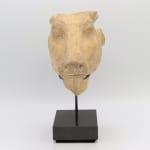Late Dynastic Limestone Head of the Apis Bull, c. 600 to 400 BCE
Limestone
height 13.5 cm
height 5 1/4 in
dimensions given without mounting
height 5 1/4 in
dimensions given without mounting
LI.3414
Further images
-
(View a larger image of thumbnail 1
)

-
(View a larger image of thumbnail 2
)

-
(View a larger image of thumbnail 3
)

-
(View a larger image of thumbnail 4
)

-
(View a larger image of thumbnail 5
)

-
(View a larger image of thumbnail 6
)

-
(View a larger image of thumbnail 7
)

-
(View a larger image of thumbnail 8
)

The 26th Dynasty, also known as the Saite Period, is traditionally placed by scholars at the end of the Third Intermediate Period or at the beginning of the Late Dynastic...
The 26th Dynasty, also known as the Saite Period, is traditionally placed by scholars at the end of the Third Intermediate Period or at the beginning of the Late Dynastic Period. In either case, the Saite Period rose from the ashes of a decentralized Egyptian state that had been ravaged by foreign occupation. Supported by the assistance of a powerful family centered in the Delta town of Sais, the Assyrians finally drove the Nubians out of Egypt. At the close of this campaign, Ashurbanipal’s kingdom was at the height of its power; however, due to civil strife back east, he was forced to withdraw his forces from Egypt. Psamtik I, a member of the family from Sais, seized this opportunity to assert his authority over the entire Nile Valley and found his own dynasty, the 26th of Egyptian history. Known as the Saite Period due to the importance of the capital city Sais, the 26th Dynasty, like many before it, sought to emulate the artistic styles of past pharaohs in order to bolster their own claims to power and legitimize their authority.
Yet despite that artist sought to replicate models of the past, Egyptian art of this era was infused with a heightened sense of naturalism. This fact is likely due to the influx of Greek culture. The Saite rulers recognized that Egypt had fallen behind the rest of the Mediterranean world in terms of military technology. Thus, they were forced to rely upon foreign mercenaries, many of whom were Greek. With ties between these two cultures firmly established during the 7th Century B.C., commercial trading quickly blossomed. Special entrepots for foreign traders were established, including the famed center of Naucratis, a Delta town in which Greek merchants were permitted access. During the Saite Period, two great powers of the Mediterranean world became intimately linked, commercially and culturally. As the exchange of ideas flowed across the sea, the Greeks began to experiment on a monumental scale while the Egyptians began to approach art with an enhanced sense of realism.
The sacred Apis bull was considered the living manifestation of the creator god Ptah. In the temple of Ptah at Memphis, the Apis bull resided, serving as an intermediary allowing mankind to communicate with this mighty deity through oracles. The average lifespan of the Apis was fourteen years during which time the upper echelons of Memphis society were able to view the creature at certain annual ceremonies in the temple of Ptah. After the Apis passed away, it was mourned as if the pharaoh himself had died. The bull would be mummified, and the embalmed and bejeweled carcass would be paraded through the city on route to the burial plot in Saqqara. Like Ptah himself, the origin of the Apis dates back from the earliest days of Egyptian history, well before the Dynastic era. After Greek occupation, during the Ptolemaic Period, the Apis bull would survive in the form of the composite deity Sarapis.
Yet despite that artist sought to replicate models of the past, Egyptian art of this era was infused with a heightened sense of naturalism. This fact is likely due to the influx of Greek culture. The Saite rulers recognized that Egypt had fallen behind the rest of the Mediterranean world in terms of military technology. Thus, they were forced to rely upon foreign mercenaries, many of whom were Greek. With ties between these two cultures firmly established during the 7th Century B.C., commercial trading quickly blossomed. Special entrepots for foreign traders were established, including the famed center of Naucratis, a Delta town in which Greek merchants were permitted access. During the Saite Period, two great powers of the Mediterranean world became intimately linked, commercially and culturally. As the exchange of ideas flowed across the sea, the Greeks began to experiment on a monumental scale while the Egyptians began to approach art with an enhanced sense of realism.
The sacred Apis bull was considered the living manifestation of the creator god Ptah. In the temple of Ptah at Memphis, the Apis bull resided, serving as an intermediary allowing mankind to communicate with this mighty deity through oracles. The average lifespan of the Apis was fourteen years during which time the upper echelons of Memphis society were able to view the creature at certain annual ceremonies in the temple of Ptah. After the Apis passed away, it was mourned as if the pharaoh himself had died. The bull would be mummified, and the embalmed and bejeweled carcass would be paraded through the city on route to the burial plot in Saqqara. Like Ptah himself, the origin of the Apis dates back from the earliest days of Egyptian history, well before the Dynastic era. After Greek occupation, during the Ptolemaic Period, the Apis bull would survive in the form of the composite deity Sarapis.







